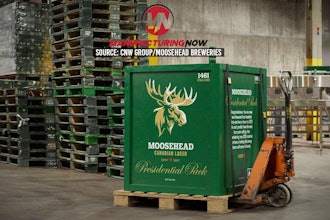On January 8, 2024, a fire broke out in the engine room aboard the 598-foot-long Stride cargo vessel while it was refueling at the Barbours Cut Marine Terminal in La Porte, Texas, about 25 miles east of Houston. Crewmembers cut all ventilation to the engine room to extinguish the fire, but not before two crewmembers, a chief engineer and a third engineer, lost their lives. Another worker was seriously injured in the incident as well.
The vessel was declared a total loss valued at $12 million, and the operating company, Danaos Shipping Company, which is based in Greece, scrapped the entire ship.
According to the NTSB, the fire was traced to an incorrect valve installed in a pipe leading to a diesel oil tank.
About six weeks before the fire, a replacement valve was ordered for one of the ship's diesel oil tanks. After the fire, NTSB investigators found the installed part was not the same type of valve specified by the vessel's fuel oil system drawing. Rather than an angle stop valve, a similar-looking valve, which only allows diesel oil to flow in one direction, even when open, was ordered and installed.
As a result of the incorrect valve installation, once diesel oil filled one tank, it was sent up the common vent line rather than to a different oil tank. In the common vent line, it flowed from a small cutout section of the vent pipe that had been sealed at an unknown time. The flexible sealing and tape covering the cutout failed, and diesel oil started "cascading onto operating machinery." The NTSB said that, due to the extensive area exposed to the overflowing fuel, it was impossible to identify the ignition source.
The NTSB couldn't nail down when the patch to the cutout section was made. The report said, "At some unknown time in the vessel's 26-year history," a 7" by 11" section of pipe had been cut into the top of the vent. The Panama-flagged ship was made in 1997.
The NTSB's report stressed that owners, operators, and crews should carefully note all components of a vessel's drawings and diagrams to make sure proper spare or replacement parts are ordered.
Another contributing factor was adequate personnel. The NTSB noted that engine crewmembers were not monitoring the tank levels as they were being filled as required by the operating company.
The company's fueling procedures required a minimum of four crewmembers to be on duty during operations. At the time of the fire, only three crewmembers were present.
WEBVTT
X-TIMESTAMP-MAP=LOCAL:00:00:00.000,MPEGTS:0
00:00.029 --> 00:06.480
On January 8, 2024, a fire broke out in the
engine room aboard the 598 ft long
00:06.480 --> 00:12.159
stride cargo vessel while it was refueling at
the Barber's Cut Marine Terminal in La Porte,
00:12.199 --> 00:15.109
Texas, about 25 miles east of Houston.
00:15.319 --> 00:19.030
Crew members cut all ventilation to the engine
room to extinguish the fire,
00:19.329 --> 00:23.750
but not before two crew members, a chief
engineer and a third engineer,
00:24.040 --> 00:27.479
lost their lives.
Another worker was seriously injured in the
00:27.479 --> 00:31.639
incident as well.
The vessel was declared a total loss valued at
00:31.639 --> 00:36.450
$12 million and the operating company, Danaus
Shipping Company,
00:36.689 --> 00:39.639
which is based in Greece, scrapped the entire
ship.
00:39.770 --> 00:46.389
According to the NTSB, the fire was traced to
an incorrect valve installed in a pipe leading
00:46.389 --> 00:48.080
to a diesel oil tank.
00:48.389 --> 00:53.150
About 6 weeks before the fire, a replacement
valve was ordered for one of the ship's diesel
00:53.150 --> 00:57.169
oil tanks.
After the fire, NTSB investigators found that
00:57.169 --> 01:01.180
the install.
Part was not the same type of valve specified
01:01.180 --> 01:05.690
by the vessel's fuel oil system drawing.
Rather than an angle stop valve,
01:05.819 --> 01:10.449
a similar looking valve, which only allows
diesel oil to flow in one direction,
01:10.739 --> 01:16.330
even when open, was ordered and installed.
Once diesel oil filled another tank to capacity,
01:16.540 --> 01:21.779
it was directed up the common vent line rather
than to the intended oil tank where it flowed
01:21.779 --> 01:26.620
from a small cut out section of the vent pipe
that had been sealed at an unknown time.
01:27.120 --> 01:30.760
The flexible ceiling and tape covering the
cutout failed,
01:30.980 --> 01:35.660
and diesel oil started quote cascading onto
operating machinery.
01:36.110 --> 01:41.099
The NTSB said that due to the extensive area
exposed to the overflowing fuel,
01:41.349 --> 01:43.980
it was impossible to identify the ignition
source.
01:44.309 --> 01:48.430
The NTSB couldn't really nail down when the
patch to the cutout section was made.
01:48.849 --> 01:53.930
The report said, quote, at some unknown time in
the vessel's 26 year history,
01:54.339 --> 01:58.739
a 7 inch by 11 inch section of pipe had been
cut into the top of the vent.
01:59.449 --> 02:05.279
The Panama flagged ship was made in 1997.
The NTSB's report stressed that owners,
02:05.360 --> 02:10.440
operators, and crews should carefully note all
components of the vessel's drawings and
02:10.440 --> 02:14.740
diagrams to make sure proper spare or
replacement parts are ordered.
02:14.850 --> 02:17.809
Another contributing factor was adequate
personnel.
02:18.000 --> 02:22.919
The NTSB noted that engine crew members were
not monitoring the tank levels as they were
02:22.919 --> 02:28.039
being filled, a procedure required by the
operating company's safety management system.
02:28.449 --> 02:33.470
The company's fueling procedures require a
minimum of 2 engineering officers and 2 engine
02:33.470 --> 02:37.279
ratings to be on duty during operations.
At the time of the fire,
02:37.470 --> 02:40.179
only 3 crew members were involved with
operations.
02:40.679 --> 02:43.149
I'm David Manti, this is manufacturing now.






















